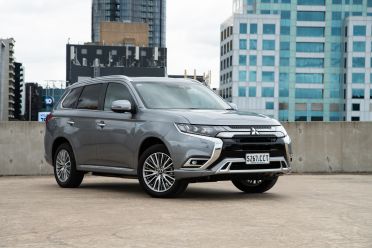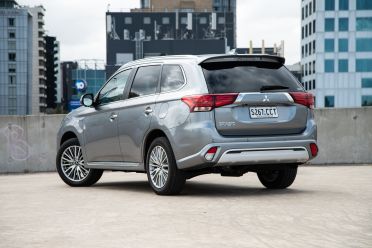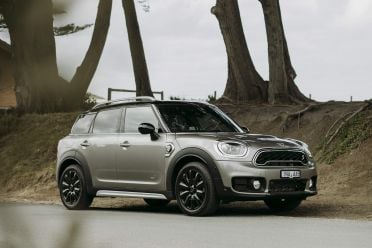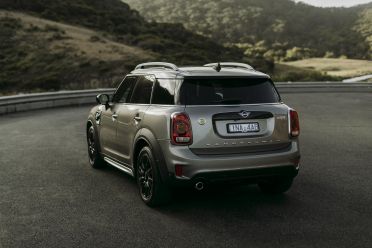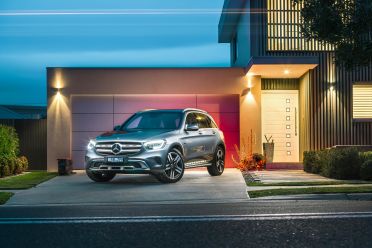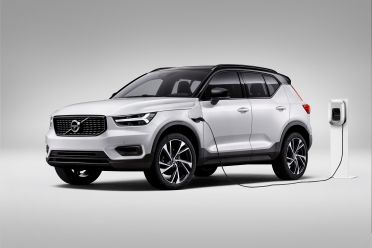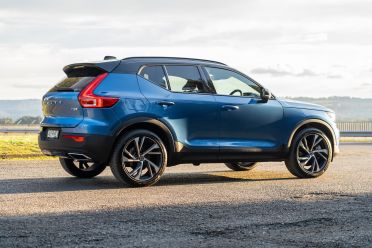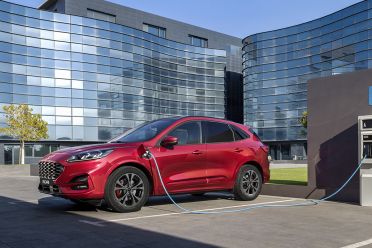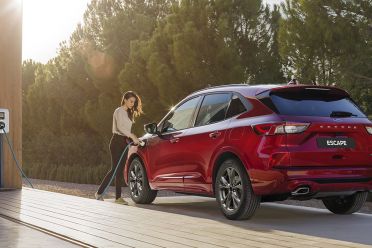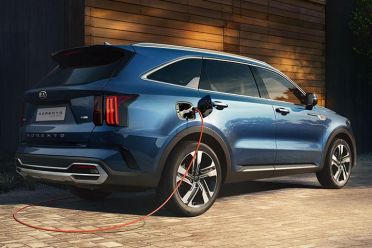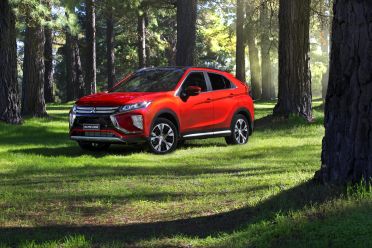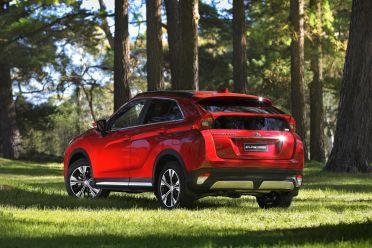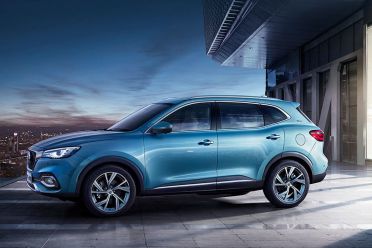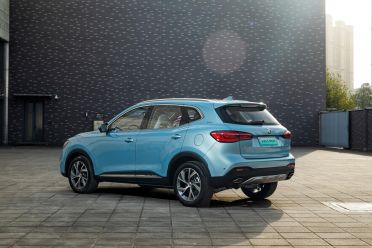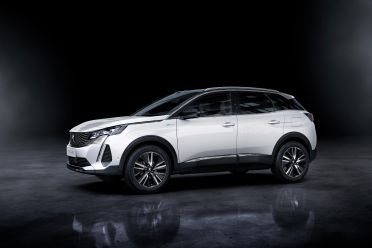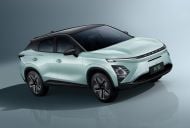In some months this year, sales of the Toyota RAV4 Hybrid have accounted for over half of all RAV4 volume. That’s hugely significant, given the RAV4’s position as Australia’s most popular mid-sized SUV.
Evidently, there’s demand for a more efficient SUV. That’s why we’ll soon see an influx of models that offer hybrid power and even do one better than the RAV4 – they’ll be plug-in hybrids.
For those unfamiliar with plug-in hybrid electric vehicles (PHEVs), they use a larger battery than a conventional hybrid and allow you to, as the name suggests, plug in to an outlet to charge it. This allows you to run exclusively on electric power for a limited range, often considerably less than an all-electric vehicle but enough to significantly reduce your fuel bill and emissions.
The idea isn’t new, with one of the RAV4 Hybrid’s key rivals making PHEV propulsion accessible all the way back in 2014.
Mitsubishi Outlander PHEV
- On sale now.
- Priced from $47,390 to $56,390 before on-road costs.
- 50km of electric range
- All-wheel drive
- New model due 2021 or 2022.
That PHEV pioneer was the Mitsubishi Outlander PHEV, which was the world’s first PHEV SUV and arrived locally in 2014. It enjoyed this segment to itself for several years and rivals have only recently started offering hybrid and plug-in hybrid powertrains in Australia.
It pairs a 2.4-litre four-cylinder petrol engine making 94kW of power and 199Nm of torque, with front and rear electric motors (60kW/137Nm and 70kW/195Nm) and a 13.8kWh lithium-ion battery. Mitsubishi doesn’t specify the combined output, though it claims an electric range of 50km. We observed 45.5km from a 90 per cent charge in our recent review.
You’ll pay around $12-13,000 more for an Outlander PHEV ES, ES ADAS or Exceed than you would for an equivalent petrol-powered, all-wheel drive model. All Outlander PHEVs are all-wheel drive and offer only two rows of seating, despite the availability of seven seats in other Outlander models.
A next-generation Outlander is due next year and there’ll be a new PHEV, featuring a new drivetrain Mitsubishi is developing for the wider Renault-Nissan-Mitsubishi Alliance. It’ll also use a new platform that will also underpin the next-generation Nissan X-Trail.
The next Outlander PHEV is likely to feature a larger battery, with electric range extending to 70km.
Mini Countryman Hybrid
- On sale now
- Priced at $57,200 before on-road costs.
- 40km of electric range
- All-wheel drive
- Updated model due later this year
If an Outlander PHEV is a little too mainstream, Mini has a plug-in hybrid SUV costing just a few hundred dollars more than the top-spec Mitsubishi.
The Countryman Hybrid mates the regular Countryman’s turbocharged 1.5-litre three-cylinder petrol engine (100kW/220Nm) with an electric motor on the rear axle (65kW/165Nm), for combined outputs of 162kW of power and 385Nm of torque.
That gives the Countryman Hybrid 40km of electric range, and also allows it to do the 0-100km/h sprint in 6.9 seconds, just 0.4 seconds off the Countryman John Cooper Works.
It also goes a long way towards justifying the $15,000 premium Mini charges for the Hybrid vis-à-vis a regular Countryman Cooper.
An updated Countryman Hybrid is due before the end of the year. It features a larger 9.6kWh lithium-ion battery, boosting pure-electric range from around 40km to a more usable 60km. There are also some styling tweaks and a new digital instrument cluster.
Mercedes-Benz GLC300e
- On sale now
- Priced at $86,300 before on-road costs
- All-wheel drive
- Pure electric range of 47km under the (more generous) NEDC standard
The Mercedes-Benz GLC300e might be the priciest PHEV on this list but it demands one of the smallest premiums over its conventional, petrol-powered counterpart.
Just $4800 separates the GLC300e from the GLC300, despite packing more power and standard equipment including air suspension. As a bonus, it also undercuts its rival from Volvo, the XC60 T8, which starts at just a shade under $100,000.
The GLC300e mates a turbocharged 2.0-litre four-cylinder petrol engine with an electric motor and a 13.5kWh lithium-ion battery. Total system output is 235kW and 700Nm, while the 0-100km/h sprint is done in just 5.7 seconds. In comparison, the GLC300 produces 190kW and 370Nm from its 2.0-litre turbo four.
Volvo XC40 Recharge PHEV
- On sale this year
- Priced at $64,990 before on-road costs
- 46km of electric range
- Front-wheel drive
- All-electric model coming soon
Some companies are rolling out all-electric vehicles locally, while others stick with hybrid power for now. Volvo is hedging its bets and offering both to Australian consumers.
Volvo’s first all-electric model, the XC40 Recharge Pure Electric EV, is due in mid-2021. In the meantime, it’s introducing the XC40 Recharge Plug-In Hybrid which will also serve as the flagship XC40 in the interim. It’s priced $8000 higher than the previous flagship, the T5 R-Design.
It uses the XC40 T3’s 135kW/265Nm 1.5-litre turbo three-cylinder petrol engine, mated with a 61kW/160Nm electric motor, 10.7kWh lithium-ion battery and seven-speed dual-clutch automatic transmission. Combined output is 195kW, sent to the front wheels only.
Ford Escape PHEV
- Due in the fourth quarter of this year
- Priced at $52,490 before on-road costs.
- Front-wheel drive
- 50km of electric range
Ford sold a hybrid Escape from 2005 until 2012 in the US and developed plug-in hybrid prototypes, only to make the following Escape purely petrol-powered. Now, hybrid power is coming back to the Escape line, and we’re going to receive it for the first time.
To be offered globally under both the Escape and Kuga nameplates, the plug-in SUV will arrive locally before year’s end. Ford is offering it only in the sporty mid-range ST-Line and it’ll command a $14,500 premium over the equivalent petrol model, though it does pick up some additional features like a 10-way power driver’s seat, partial leather upholstery and a 10-speaker sound system.
You can view a more complete list of features on our pricing and specs article.
The Escape PHEV is front-wheel drive and mates a naturally-aspirated 2.5-litre four-cylinder engine to an electric motor and a 14.4kWh lithium-ion battery. Combined output is 167kW, and claimed pure-electric range is 50km.
Kia Sorento PHEV
- On sale in the first half of 2021
- Seats five or seven
- 40-50km of electric range
Kia’s first PHEV in Australia will be an electrified version of its all-new Sorento. While most of the PHEVs on this list are mid-sized SUVs, the Sorento is a class above in size and will offer a third row of seats – something even the Outlander PHEV lacks despite the regular Outlander seating up to seven.
The Sorento will be unique in offering both conventional hybrid and plug-in hybrid variants. In contrast, the upcoming Hyundai Santa Fe and Toyota Kluger redesigns will offer only conventional hybrids; the Nissan Pathfinder also offers only a hybrid.
Both the hybrid and plug-in hybrid mate a turbocharged 1.6-litre four-cylinder engine with an electric motor and a lithium-ion battery pack. The Sorento PHEV has a substantially higher-capacity battery pack, however: 13.8kWh vs. 1.49kWh. Its electric motor is also more powerful, with outputs of 67kW and 304Nm. Total system output is 195kW and 350Nm, with an electric range of between 40 and 50km.
Mitsubishi Eclipse Cross PHEV
- On sale in 2021
Following the success of the Outlander PHEV, Mitsubishi plans to introduce this technology to its small Eclipse Cross.
It’ll arrive after the updated petrol model, due in the fourth quarter of this year, which promises “a fresh new look, revised interior, and new infotainment system”.
We don’t yet know the technical details of the Eclipse Cross PHEV’s powertrain. It could share its mechanicals with the Outlander PHEV, or it could debut the new PHEV drivetrain Mitsubishi is developing for the next-generation Outlander PHEV.
MG e-HS
- On sale in the first half of 2021
- Front-wheel drive
- 75km of electric range
MG’s new mid-sized HS range is continuing to expand. First came top-spec Essence and Essence Anfield models this year, while next year will see the introduction of a more powerful 2.0-litre turbocharged four and the first plug-in hybrid model for MG in Australia.
The e-HS, as it’ll be called, will be powered by a turbocharged 1.5-litre four-cylinder petrol engine mated to a 90kW electric motor and a 16.6kWh lithium–ion battery. MG claims a combined 217kW of power and 480Nm of torque from the hybrid powertrain, with torque sent to the front wheels through a 10-speed automatic transmission.
MG claims an electric range of 75km, higher than rivals from Ford and Mitsubishi.
Peugeot 3008
- On sale in the first half of 2021
- Front-wheel drive or all-wheel drive
- 56-59km of electric range
While some PHEV SUVs are front-wheel drive only and others only come with all-wheel drive, Peugeot plans to offer both in the 3008 range before the second half of next year.
The front-wheel drive 3008 PHEV uses Peugeot’s PureTech turbocharged 1.6-litre four-cylinder engine with 132kW of power, mated to an 11.8kWh lithium-ion battery and an 80kW electric motor. Combined system output is 165kW, with an electric driving range of 56km.
The all-wheel drive 3008 GT Hybrid4 adds a second 80kW electric motor, situated on the rear axle. The battery pack is also slightly larger at 13.2kWh, while the PureTech four produces 147kW of power. All up, the GT Hybrid4 has a combined system output of 221kW and a total electric range of 59km.
BMW X3 xDrive30e
- Was set to be introduced Q2 of 2020, delayed
- All-wheel drive
- 46km of electric range
Pricing for the BMW X3 xDrive30e has yet to be announced so it mightn’t slide in under our $90,000 cap.
Should it do so, however, it’ll pose the most direct threat to the Mercedes-Benz GLC300e when it eventually arrives.
It offers almost identical electric range (only 1km off the Benz), though its performance figures are a touch lower: total system output is 215kW/420Nm, with the 0-100km/h sprint dispatched in 6.1 seconds.
It mates a turbocharged 2.0-litre four-cylinder petrol engine with an electric motor and a 12kWh lithium-ion battery.
The same plug-in powertrain is also used in the BMW 330e, which commands a $4000 price premium over an equivalent 330i. The conventional petrol BMW X3 xDrive30i costs $73,900 before on-roads, or $81,900 in M Sport guise, so there’s a good chance this plug-in Bimmer will slide in under $90,000.




